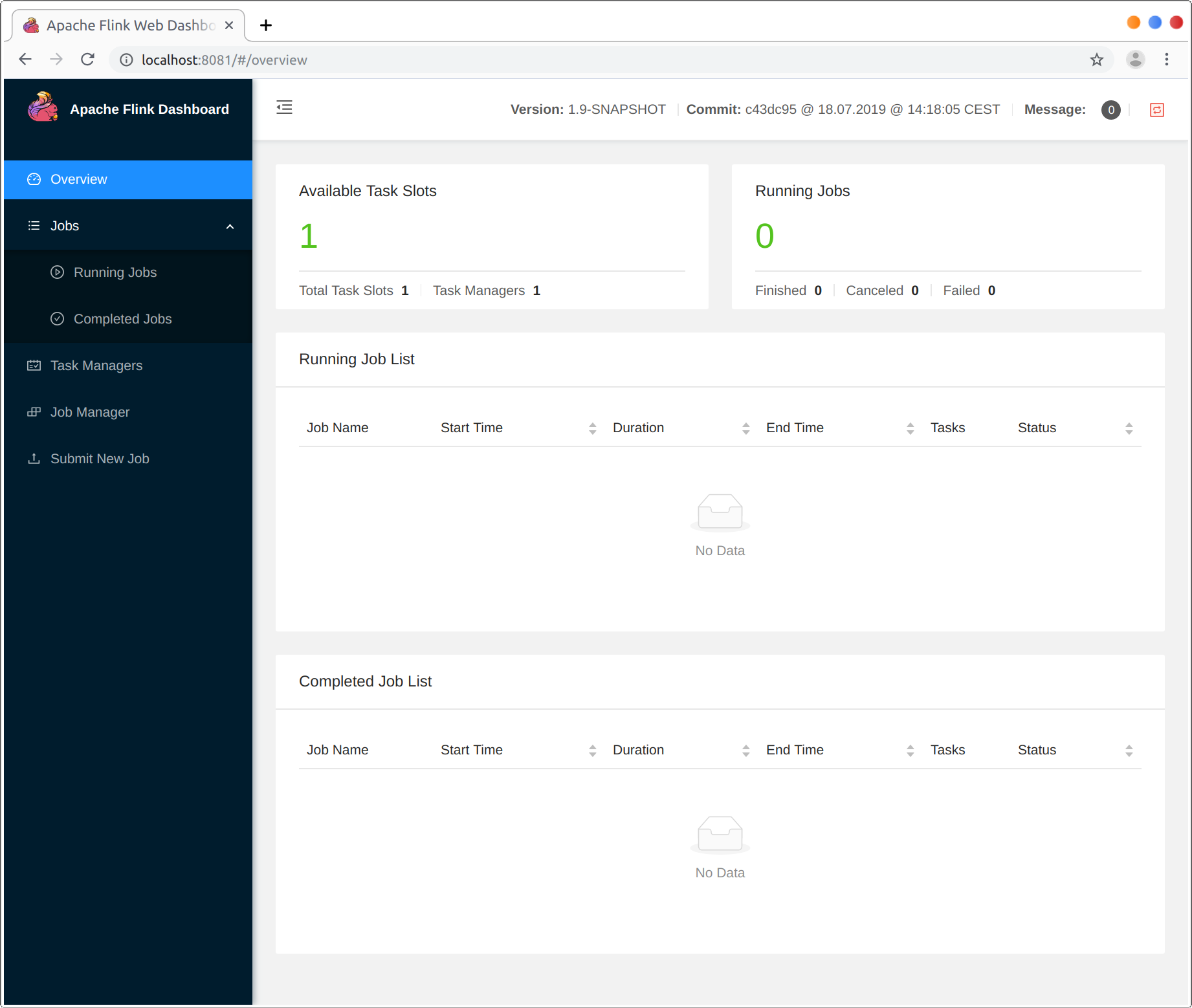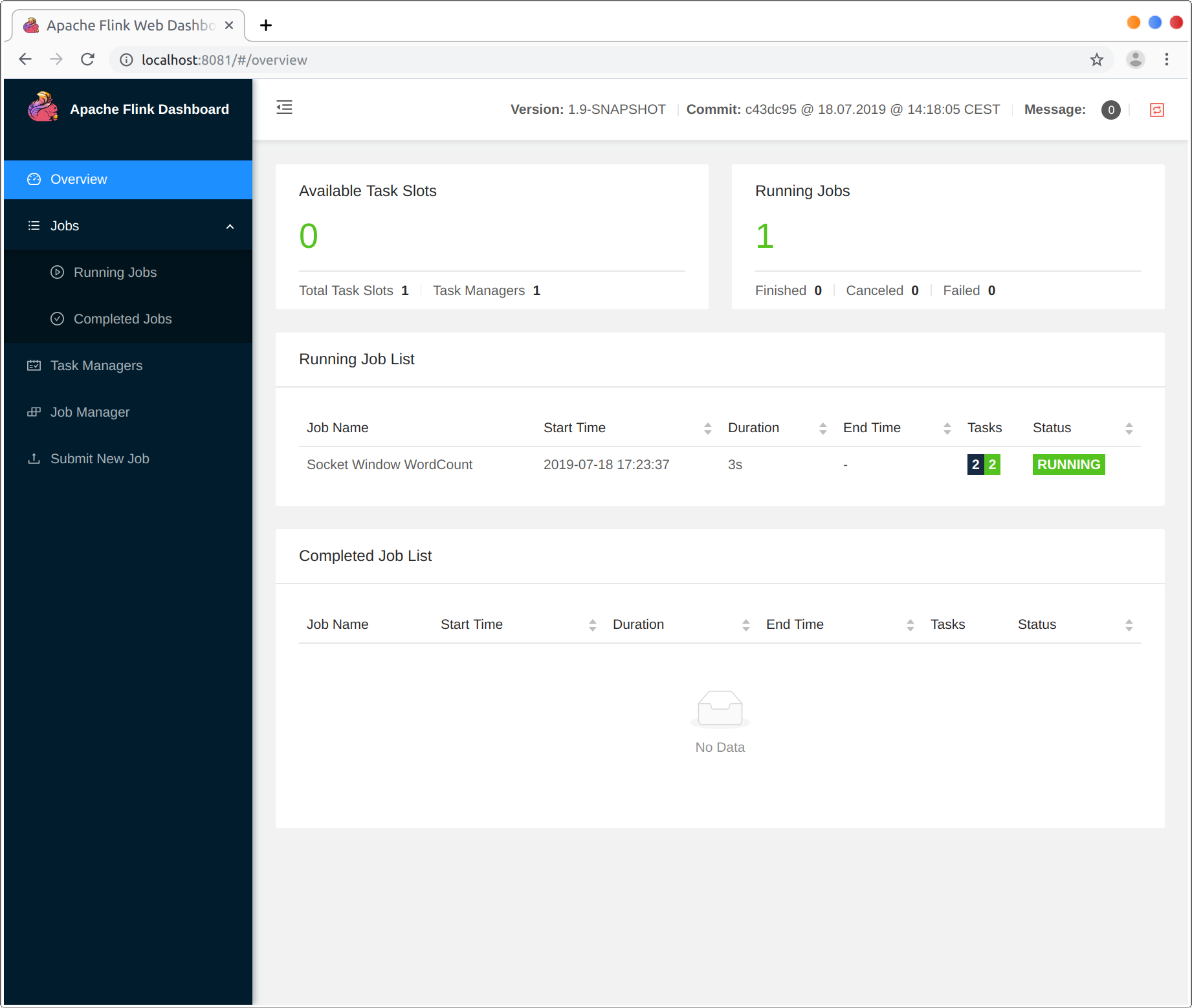Local Setup Tutorial
Get a Flink example program up and running in a few simple steps.
Setup: Download and Start Flink
Flink runs on Linux and Mac OS X. Note: Windows users can run Flink in Cygwin or WSL. To be able to run Flink, the only requirement is to have a working Java 8 or 11 installation. You can check the correct installation of Java by issuing the following command:
java -versionIf you have Java 8, the output will look something like this:
java version "1.8.0_111"
Java(TM) SE Runtime Environment (build 1.8.0_111-b14)
Java HotSpot(TM) 64-Bit Server VM (build 25.111-b14, mixed mode)- Download a binary from the downloads page. You can pick
any Scala variant you like. For certain features you may also have to download one of the pre-bundled Hadoop jars
and place them into the
/libdirectory. - Go to the download directory.
- Unpack the downloaded archive.
$ cd ~/Downloads # Go to download directory
$ tar xzf flink-*.tgz # Unpack the downloaded archive
$ cd flink-1.10.2For MacOS X users, Flink can be installed through Homebrew.
$ brew install apache-flink
...
$ flink --version
Version: 1.2.0, Commit ID: 1c659cfStart a Local Flink Cluster
$ ./bin/start-cluster.sh # Start FlinkCheck the Dispatcher’s web frontend at http://localhost:8081 and make sure everything is up and running. The web frontend should report a single available TaskManager instance.
You can also verify that the system is running by checking the log files in the logs directory:
$ tail log/flink-*-standalonesession-*.log
INFO ... - Rest endpoint listening at localhost:8081
INFO ... - http://localhost:8081 was granted leadership ...
INFO ... - Web frontend listening at http://localhost:8081.
INFO ... - Starting RPC endpoint for StandaloneResourceManager at akka://flink/user/resourcemanager .
INFO ... - Starting RPC endpoint for StandaloneDispatcher at akka://flink/user/dispatcher .
INFO ... - ResourceManager akka.tcp://flink@localhost:6123/user/resourcemanager was granted leadership ...
INFO ... - Starting the SlotManager.
INFO ... - Dispatcher akka.tcp://flink@localhost:6123/user/dispatcher was granted leadership ...
INFO ... - Recovering all persisted jobs.
INFO ... - Registering TaskManager ... at ResourceManagerRead the Code
You can find the complete source code for this SocketWindowWordCount example in scala and java on GitHub.
object SocketWindowWordCount {
def main(args: Array[String]) : Unit = {
// the port to connect to
val port: Int = try {
ParameterTool.fromArgs(args).getInt("port")
} catch {
case e: Exception => {
System.err.println("No port specified. Please run 'SocketWindowWordCount --port <port>'")
return
}
}
// get the execution environment
val env: StreamExecutionEnvironment = StreamExecutionEnvironment.getExecutionEnvironment
// get input data by connecting to the socket
val text = env.socketTextStream("localhost", port, '\n')
// parse the data, group it, window it, and aggregate the counts
val windowCounts = text
.flatMap { w => w.split("\\s") }
.map { w => WordWithCount(w, 1) }
.keyBy("word")
.timeWindow(Time.seconds(5), Time.seconds(1))
.sum("count")
// print the results with a single thread, rather than in parallel
windowCounts.print().setParallelism(1)
env.execute("Socket Window WordCount")
}
// Data type for words with count
case class WordWithCount(word: String, count: Long)
}public class SocketWindowWordCount {
public static void main(String[] args) throws Exception {
// the port to connect to
final int port;
try {
final ParameterTool params = ParameterTool.fromArgs(args);
port = params.getInt("port");
} catch (Exception e) {
System.err.println("No port specified. Please run 'SocketWindowWordCount --port <port>'");
return;
}
// get the execution environment
final StreamExecutionEnvironment env = StreamExecutionEnvironment.getExecutionEnvironment();
// get input data by connecting to the socket
DataStream<String> text = env.socketTextStream("localhost", port, "\n");
// parse the data, group it, window it, and aggregate the counts
DataStream<WordWithCount> windowCounts = text
.flatMap(new FlatMapFunction<String, WordWithCount>() {
@Override
public void flatMap(String value, Collector<WordWithCount> out) {
for (String word : value.split("\\s")) {
out.collect(new WordWithCount(word, 1L));
}
}
})
.keyBy("word")
.timeWindow(Time.seconds(5), Time.seconds(1))
.reduce(new ReduceFunction<WordWithCount>() {
@Override
public WordWithCount reduce(WordWithCount a, WordWithCount b) {
return new WordWithCount(a.word, a.count + b.count);
}
});
// print the results with a single thread, rather than in parallel
windowCounts.print().setParallelism(1);
env.execute("Socket Window WordCount");
}
// Data type for words with count
public static class WordWithCount {
public String word;
public long count;
public WordWithCount() {}
public WordWithCount(String word, long count) {
this.word = word;
this.count = count;
}
@Override
public String toString() {
return word + " : " + count;
}
}
}Run the Example
Now, we are going to run this Flink application. It will read text from a socket and once every 5 seconds print the number of occurrences of each distinct word during the previous 5 seconds, i.e. a tumbling window of processing time, as long as words are floating in.
- First of all, we use netcat to start local server via
$ nc -l 9000- Submit the Flink program:
$ ./bin/flink run examples/streaming/SocketWindowWordCount.jar --port 9000
Starting execution of programThe program connects to the socket and waits for input. You can check the web interface to verify that the job is running as expected:
- Words are counted in time windows of 5 seconds (processing time, tumbling
windows) and are printed to
stdout. Monitor the TaskManager’s output file and write some text innc(input is sent to Flink line by line after hitting):
$ nc -l 9000
lorem ipsum
ipsum ipsum ipsum
byeThe .out file will print the counts at the end of each time window as long
as words are floating in, e.g.:
$ tail -f log/flink-*-taskexecutor-*.out
lorem : 1
bye : 1
ipsum : 4To stop Flink when you’re done type:
$ ./bin/stop-cluster.shNext Steps
Check out some more examples to get a better feel for Flink’s programming APIs. When you are done with that, go ahead and read the streaming guide.



